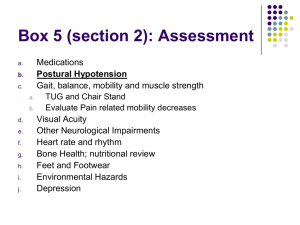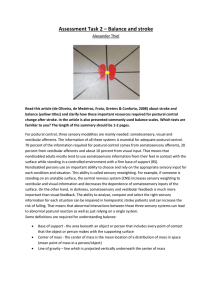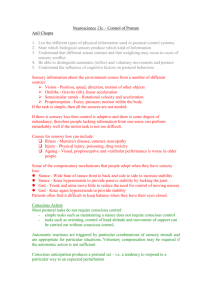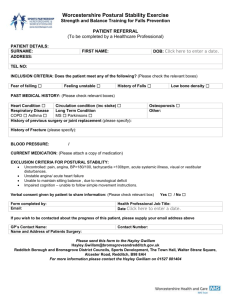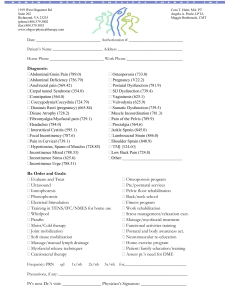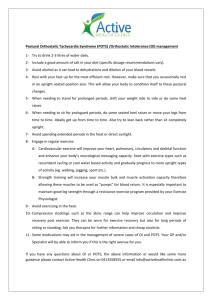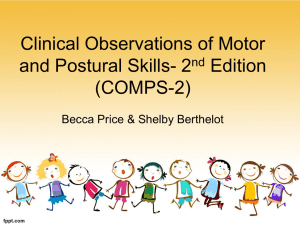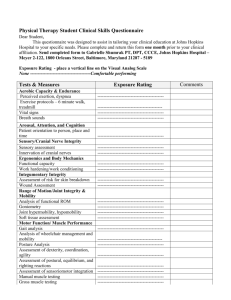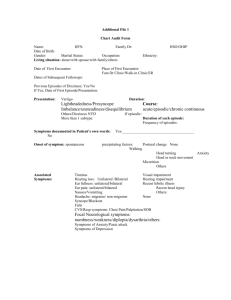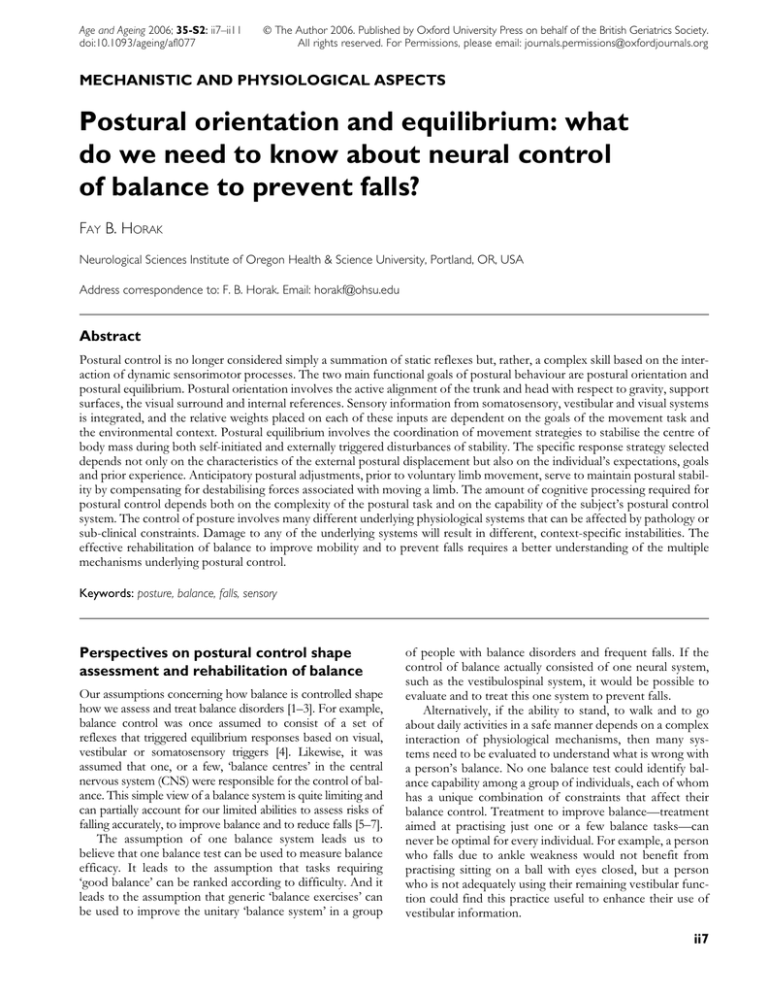
Age and Ageing 2006; 35-S2: ii7–ii11
doi:10.1093/ageing/afl077
© The Author 2006. Published by Oxford University Press on behalf of the British Geriatrics Society.
All rights reserved. For Permissions, please email: journals.permissions@oxfordjournals.org
MECHANISTIC AND PHYSIOLOGICAL ASPECTS
Postural orientation and equilibrium: what
do we need to know about neural control
of balance to prevent falls?
FAY B. HORAK
Neurological Sciences Institute of Oregon Health & Science University, Portland, OR, USA
Address correspondence to: F. B. Horak. Email: horakf@ohsu.edu
Abstract
Postural control is no longer considered simply a summation of static reflexes but, rather, a complex skill based on the interaction of dynamic sensorimotor processes. The two main functional goals of postural behaviour are postural orientation and
postural equilibrium. Postural orientation involves the active alignment of the trunk and head with respect to gravity, support
surfaces, the visual surround and internal references. Sensory information from somatosensory, vestibular and visual systems
is integrated, and the relative weights placed on each of these inputs are dependent on the goals of the movement task and
the environmental context. Postural equilibrium involves the coordination of movement strategies to stabilise the centre of
body mass during both self-initiated and externally triggered disturbances of stability. The specific response strategy selected
depends not only on the characteristics of the external postural displacement but also on the individual’s expectations, goals
and prior experience. Anticipatory postural adjustments, prior to voluntary limb movement, serve to maintain postural stability by compensating for destabilising forces associated with moving a limb. The amount of cognitive processing required for
postural control depends both on the complexity of the postural task and on the capability of the subject’s postural control
system. The control of posture involves many different underlying physiological systems that can be affected by pathology or
sub-clinical constraints. Damage to any of the underlying systems will result in different, context-specific instabilities. The
effective rehabilitation of balance to improve mobility and to prevent falls requires a better understanding of the multiple
mechanisms underlying postural control.
Keywords: posture, balance, falls, sensory
Perspectives on postural control shape
assessment and rehabilitation of balance
Our assumptions concerning how balance is controlled shape
how we assess and treat balance disorders [1–3]. For example,
balance control was once assumed to consist of a set of
reflexes that triggered equilibrium responses based on visual,
vestibular or somatosensory triggers [4]. Likewise, it was
assumed that one, or a few, ‘balance centres’ in the central
nervous system (CNS) were responsible for the control of balance. This simple view of a balance system is quite limiting and
can partially account for our limited abilities to assess risks of
falling accurately, to improve balance and to reduce falls [5–7].
The assumption of one balance system leads us to
believe that one balance test can be used to measure balance
efficacy. It leads to the assumption that tasks requiring
‘good balance’ can be ranked according to difficulty. And it
leads to the assumption that generic ‘balance exercises’ can
be used to improve the unitary ‘balance system’ in a group
of people with balance disorders and frequent falls. If the
control of balance actually consisted of one neural system,
such as the vestibulospinal system, it would be possible to
evaluate and to treat this one system to prevent falls.
Alternatively, if the ability to stand, to walk and to go
about daily activities in a safe manner depends on a complex
interaction of physiological mechanisms, then many systems need to be evaluated to understand what is wrong with
a person’s balance. No one balance test could identify balance capability among a group of individuals, each of whom
has a unique combination of constraints that affect their
balance control. Treatment to improve balance—treatment
aimed at practising just one or a few balance tasks—can
never be optimal for every individual. For example, a person
who falls due to ankle weakness would not benefit from
practising sitting on a ball with eyes closed, but a person
who is not adequately using their remaining vestibular function could find this practice useful to enhance their use of
vestibular information.
ii7
F. B. Horak
Postural control is no longer considered one system or a
set of righting and equilibrium reflexes. Rather, postural control is considered a complex motor skill derived from the
interaction of multiple sensorimotor processes [8]. The two
main functional goals of postural control are postural orientation and postural equilibrium. Postural orientation involves
the active control of body alignment and tone with respect to
gravity, support surface, visual environment and internal references. Spatial orientation in postural control is based on the
interpretation of convergent sensory information from somatosensory, vestibular and visual systems. Postural equilibrium
involves the coordination of sensorimotor strategies to stabilise
the body’s centre of mass (CoM) during both self-initiated
and externally triggered disturbances in postural stability.
It is widely recognised that older people with balance disorders suffer from multiple impairments, such as multi-sensory loss, weakness, orthopaedic constraints and cognitive
impairments [9, 10]. It is often assumed that these impairments lead directly to functional loss, such as the inability to
walk safely, to climb stairs and to dress independently. Too
often, we forget that impairments, alone, do not lead to
functional deficits because some people with a particular
impairment have much better function than others, depending on the type of impairment and the strategies each uses to
compensate for the impairment. For example, an individual
with sensory loss in the feet due to neuropathy may compensate by increasing dependence on visual information [11]—a
strategy that results in instability in the dark. Another individual may compensate by using sensory substitution from
light touch on a cane or walker [12], which is helpful in maintaining stability in the dark but may become an obstacle
when the person needs to step quickly to the side to recover
their equilibrium in response to a perturbation [13]. Thus,
quantifying somatosensory loss in the feet, although helpful,
cannot fully predict balance function because function also
depends on strategies that individuals use to accomplish stability for a particular task given the impairments.
The postural system consists of many
subcomponents
Just as it is important to consider the compensatory strategies that individuals use to function on a daily basis, despite
their impairments, it is important to understand the normal
strategies that the CNS uses to control balance. Another
approach to understand postural control requires considering the many physiological systems underlying a person’s
ability to stand, to walk and to interact with the environment safely and efficiently. An understanding of these systems and their different contributions to postural control
allows us to systematically analyse the particular balance disorders affecting each individual. This analysis also allows us
to predict context-specific instability, in which each individual is at risk of falling in different contexts. For example, an
individual who is incapable of using vestibular information
will be at risk of falling in the dark on unstable surface,
whereas an individual who requires a stepping strategy to
control equilibrium will be unstable when they must balance
with their feet in place [14].
ii8
Figure 1. Important resources required for postural stability
and orientation. Disorders in any of these resources may be the
cause of balance disorders and the increased incidence of falls
in the elderly, as shown by the graph. This framework suggests
that each elderly individual is falling because of specific, unique
constraints on their postural control system.
A summary of six important resources important for
postural control is shown in Figure 1. A disorder in any one,
or a combination, of these resources leads to postural instability. The graph in the centre of Figure 1 shows the wellknown increased risk of balance disorders and falls as
people age. This increase associated with ageing, however, is
not due to ageing of ‘the balance system’ but to an increased
likelihood of impairment or pathology in physiological subsystems underlying the complex skill of balancing [5].
Biomechanical constraints
The most important biomechanical constraint on balance is
the size and quality of the base of support: the feet. Any limitations in size, strength, range, pain or control of the feet
will affect balance [15]. One of the most important biomechanical constraints on balance control involves controlling
the body CoM with respect to its base of support. In stance,
the limits of stability —that is, the area over which an individual can move their CoM and maintain equilibrium without changing the base of support—are shaped like a cone as
shown in Figure 2 [2, 16]. Thus, equilibrium is not a particular position but a space determined by the size of the support base (the feet in stance) and the limitations on joint
range, muscle strength and sensory information available to
detect the limits. The CNS has an internal representation of
this cone of stability that it uses to determine how to move
to maintain equilibrium. In many elderly people with balance disorders, this cone of stability is often very small or
their central neural representations of this cone of stability
are distorted, both of which affect their selection of movement strategies to maintain equilibrium. Figure 2 shows a
man demonstrating a normal forward limit of stability and a
woman with multisensory problems demonstrating a
severely reduced limit of stability. The man leans from his
Postural orientation and equilibrium
response to an external perturbation, individuals can influence which strategy is selected and the magnitude of their
responses based on intention, experience and expectations
[23–25]. Anticipatory postural strategies, before voluntary
movement, also help maintain stability by compensating for
anticipated destabilisation associated with moving a limb.
Subjects with poorly coordinated automatic postural
responses show postural instability in response to external
perturbations whereas subjects with poorly coordinated
anticipatory postural adjustments show postural instability
during self-initiated movements [26].
Figure 2. Normal and abnormal limits of stability. (A) Healthy
man leaning his body’s centre of mass (CoM) (white dot)
towards his forward limits of stability, represented as the area
of a cone. (B) Woman with multisensory deficits attempts to
lean forward without moving her body CoM forward. (C)
Woman with multisensory deficits attempts to lean backwards
but immediately takes a step to increase her base of support.
The projection of the body CoM over the base of foot support
is indicated schematically with a white arrow.
ankles to bring his CoM towards the front of his feet. In
contrast, when the woman attempts to lean in the forward
direction, she flexes at the hips to limit forward CoM
motion, and when she attempts to lean in the backward direction, she immediately takes a step to move her base of
support under her very small CoM displacement. Subjects
prone to falls tend to have small limits of stability [17]. It is
important for the CNS to have an accurate central representation of the stability limits of the body. Basal ganglia
disorders, such as Parkinson’s disease, may result in abnormal representation of limits of stability, leading to postural
instability.
Movement strategies
Three main types of movement strategies can be used to
return the body to equilibrium in a stance position: two
strategies keep the feet in place and the other strategy
changes the base of support through the individual stepping
or reaching [18, 19]. The ankle strategy, in which the body
moves at the ankle as a flexible inverted pendulum, is
appropriate to maintain balance for small amounts of sway
when standing on a firm surface. The hip strategy, in which
the body exerts torque at the hips to quickly move the body
CoM, is used when persons stand on narrow or compliant
surfaces that do not allow adequate ankle torque or when
CoM must be moved quickly [20].
Taking a step to recover equilibrium is common, especially during gait and when keeping the feet in place is not
important. However, even when persons step in response to
an external perturbation, they first attempt to return the
CoM to the initial position by exerting angle torque. An elderly individual at risk of falling tends to use the stepping,
reaching and hip strategies more than an individual with a
low risk of falling and who uses the ankle strategy [21] to
maintain postural stability. However, fear of falling can also
lead to additional use of the hip strategy [22]. Although postural movement strategies have been triggered at 100 ms in
Sensory strategies
Sensory information from somatosensory, visual and vestibular systems must be integrated to interpret complex
sensory environments. As subjects change the sensory
environment, they need to re-weight their relative
dependence on each of the senses. In a well-lit environment with a firm base of support, healthy persons rely on
somatosensory (70%), vision (10%) and vestibular (20%)
information [27]. However, when they stand on an unstable surface, they increase sensory weighting to vestibular
and vision information as they decrease their dependence
on surface somatosensory inputs for postural orientation
[27]. The ability to re-weight sensory information depending on the sensory context is important for maintaining
stability when an individual moves from one sensory context to another, such as from a well-lit sidewalk to a dimly
lit garden. Individuals with peripheral vestibular loss or
somatosensory loss from neuropathy are limited in their
ability to re-weight postural sensory dependence and,
thus, are at risk of falling in particular sensory contexts.
Some CNS disorders, such as Alzheimer’s disease, may
impair the ability of the CNS to quickly re-weight sensory
dependence, even when the peripheral sensory system is
intact.
Orientation in space
The ability to orient the body parts with respect to gravity,
the support surface, visual surround and internal references
is a critical component of postural control. Healthy nervous
systems automatically alter how the body is orientated in
space, depending on the context and the task. For example,
a person may orient the body perpendicular to the support
surface until the support surface tilts, and then they orient
their posture to gravity. Healthy individuals can identify
gravitational vertical in the dark to within 0.5° degrees.
Studies have shown that perception of verticality, or
upright, may have multiple neural representations [28]. In
fact, the perception of visual verticality, or the ability to
align a line to gravitational vertical in the dark, is independent of the perception of postural (or proprioceptive) verticality; for example the ability to align the body in space
without vision [29]. Thus, the internal representation of visual, but not postural, verticality is tilted in persons with unilateral vestibular loss, whereas the internal representation of
postural, but not visual, verticality is tilted in persons with
hemi-neglect due to stroke [30]. A tilted or inaccurate
internal representation of verticality will result in automatic
ii9
F. B. Horak
postural alignment that is not aligned with gravity and,
therefore, renders a person unstable.
Control of dynamics
The control of balance during gait and while changing from
one posture to another requires complex control of a moving body CoM. Unlike quiet stance, a healthy person’s body
CoM is not within the base of foot support when walking or
changing from one posture to another [31]. Forward postural stability during gait comes from placing the swing limb
under the falling CoM. However, lateral stability comes from
a combination of lateral trunk control and lateral placement
of the feet [32]. Older people who are prone to falls tend to
have larger-than-normal lateral excursions of the body CoM
and more irregular lateral foot placements [33].
Cognitive processing
Many cognitive resources are required in postural control [34].
Even standing quietly requires cognitive processing, as can
be seen by increased reaction times in persons standing
compared with those in persons who are sitting with support. The more difficult the postural task, the more cognitive
processing is required. Thus, reaction times and performance in a cognitive task decline as the difficulty of the postural task increases [34]. Because the control of posture and
other cognitive processing share cognitive resources, performance of postural tasks is also impaired by a secondary
cognitive task [35]. Individuals who have limited cognitive
processing due to neurological impairments may use more of
their available cognitive processing to control posture. Falls
can result from insufficient cognitive processing to control
posture while occupied with a secondary cognitive task.
Postural control and falls are
context-dependent
Because each individual has a unique set of system constraints and resources available to control posture, the ability to maintain equilibrium and postural orientation will
depend on the particular context. Thus, different persons
will fall in different situations, depending on what systems
are required to complete the task successfully. Table 1 provides examples of different contexts that determine successful postural performance.
Just as identifying risk factors of falling is multi-factorial,
so too is identifying physiological risks for balance disorders. To predict risks of falling and to design an optimal
intervention for persons with balance impairments, it is
Table 1. Postural performance depends on context
Biomechanical task constraints
Movement strategies
Sensory environment
Postural orientation
Dynamics of control
Cognitive resources
Experience and practice
Perception of goal and context
ii10
important to assess the integrity of underlying physiological
systems and compensatory strategies available. Simple global measures of ‘balance’ are insufficient to provide the
information needed to predict the particular environments
and situations that will result in an individual’s postural control system failing. Simple ‘balance measures’ cannot identify specific constraints on the sensorimotor processes
underlying postural dyscontrol to customise balance rehabilitation for those constraints. Thus, comprehensive evaluation by a clinician skilled at systematically evaluating the
impairments and strategies underlying functional performance in postural stability is necessary for optimal balance
rehabilitation and fall prevention.
Key points
• Postural control is a complex motor skill based on interaction of dynamic sensorimotor processes.
• Balance function depends on strategies that individuals
use to accomplish stability for a particular task given
their impairments.
• Damage to different systems underlying postural control
results in different, context-specific instabilities.
• Effective assessment and rehabilitation of balance disorders require an understanding of the many systems
underlying postural control.
Acknowledgements
This work was supported by NIA AG006457 and
AG019706.
Conflicts of interest
The author declares that there are no conflicts of interest.
All subjects used in these experiments have given
informed consent and have been advised that their subject
information will be kept confidential.
References
1. Horak FB. Assumptions underlying motor control for neurologic rehabilitation. In: Contemporary Management of Motor
Control Problems. Alexandria, VA: American Physical Therapy Association, 1990; 11–27.
2. Crutchfield C, Shumway-Cook A, Horak FB. Balance and
coordination training. In: Scully R, Barnes M, eds. Physical
Therapy. New York: Lippincott, 1989; 825–43.
3. Horak FB, Shumway-Cook A. Clinical implications of postural
control research. In: Duncan PW, ed. Balance: Proceedings of
the APTA Forum. American Alexandria, VA: Physical Therapy Association, 1990; 105–11.
4. Magnus R. Chapter 10. In: Van Harreveld A, ed. Body Posture
(Korperstellung). Berlin: Springer Verlag, 1924; 571–629.
5. Horak FB, Shupert CL. Components of postural dyscontrol in
the elderly: a review. Neurobiol Ageing 1989; 10: 727–38.
6. Bloem BR, Grimbergen YA, Cramer M, Willemsen AT,
Zwinderman AH. Prospective assessment of falls in Parkinson’s disease. J Neurol 2001; 248: 950–8.
Postural orientation and equilibrium
7. Topper AK, Maki BE, Holliday PJ. Are activity-based assessments of balance and gait in the elderly predictive of risk of
falling and/or type of fall? J Am Ger Soc 1993; 41: 479–87.
8. Horak FB, Macpherson JM. Postural orientation and equilibrium. In: Rowell LB, Shepard JT, eds. Handbook of Physiology: Section 12, Exercise Regulation and Integration of
Multiple Systems. New York: Oxford University Press, 1996;
255–92.
9. Lord SR, Ward JA, Williams P, Anstey J. Physiological factors
associated with falls in older community-dwelling women. J
Am Geriat Soc 1994; 42: 1110–7.
10. Tinetti ME, Inouye SK, Gill TM, Doucette JT. Shared risk factors for falls, incontinence and functional dependence: unifying the approach to geriatric syndromes. J Am Med Assoc
1995; 273: 1348–53.
11. Horak FB, Hlavacka F. Somatosensory loss increases vestibulospinal sensitivity. J Neurophysiol 2001; 86: 575–85.
12. Dickstein R, Peterka RJ, Horak FB. Effects of light fingertip
touch on postural responses in subjects with diabetic neuropathy. J Neurol Neurosurg Psych 2003; 74: 620–6.
13. Zettel JL, McIlroy WE, Maki B. Can stabilizing features of
rapid triggered stepping reactions be modulated to meet environmental constraints? Exp Brain Res 2002; 145: 297–308.
14. Runge CF, Shupert CL, Horak FB, Zajac FE. Ankle and hip
postural strategies defined by joint torques. Gait Posture 1999;
10: 161–70.
15. Tinetti ME, Speechlev M, Ginter SF. Risk factors for falls
among elderly persons living in the community. N Eng J Med
1988; 319: 1701–7.
16. McCollum G, Leen TK. Form and exploration of mechanical
stability limits in erect stance. J Motor Behav 1989; 21: 225–44.
17. Duncan PW, Weiner DK, Chandler J, Studenski S. Functional
reach: a new clinical measure of balance. J Gerontol 1990; 45:
M192–7.
18. Horak FB.Clinical measurement of postural control in adults.
Phys Ther 1987; 67: 1881–5.
19. McIlroy WE, Maki BE. Age-related changes in compensatory
stepping in response to unpredictable perturbations. J Gerontol 1996; 51: M289–96.
20. Horak FB, Kuo A. Postural adaptation for altered environments,
tasks and intentions. In: Biomechanics and Neuronal Control of
Posture and Movement. New York: Springer, 2000; 267–81.
21. Maki BE, Edmondstone MA, McIlroy WE. Age-related differences in laterally directed compensatory stepping behaviour. J
Gerontol 2000; 55A: M270–7.
22. Adkin AL, Frank JS, Carpenter MG, Peysar GW. Postural
control is scaled to level of postural threat. Gait Posture 2000;
12: 87–93.
23. Shupert CL, Horak FB. Adaptation of postural control in normal and pathologic ageing: implications for fall prevention
programs. J Appl Biomech 1999; 15: 64–74.
24. Burleigh AL, Horak FB, Malouin F. Modification of postural
responses and step initiation: evidence for goal directed postural interactions. J Neurophys 1994; 71: 2892–902.
25. Horak FB.Adaptation of automatic postural responses. In:
Acquisition of Motor Behaviour in Vertebrates. Cambridge,
MA: MIT Press, 1996; 57–85.
26. Horak FB, Frank JS, Nutt JG. Effects of dopamine on postural control in Parkinsonian subjects: scaling, set and tone. J
Neurophys 1996; 75: 2380–96.
27. Peterka RJ.Sensorimotor integration in human postural control. J Neurophys 2002; 88: 1097–118.
28. Karnath HO, Ferber S, Dichgans J. The neural representation
of postural control in humans. PNAS 2000; 97: 13931–6.
29. Bisdorff AR, Wolsley CJ, Anastasopoulos D, Bronstein AM,
Gresty MA. The perception of body verticality (subject postural vertical) in peripheral and central vestibular disorders.
Brain 1996; 119: 1523–34.
30. Karnath HO, Fetter M, Niemeier M. Disentangling gravitational, environmental, and egocentric reference frames in spatial neglect. J Cogn Neurosci 1998; 10: 680–90.
31. Winter DA, MacKinnon CD, Ruder GK, Wieman C. An integrated EMG/biomechanical model of upper body balance and
posture during human gait. Prog Brain Res 1993; 97: 359–67.
32. Bauby CE, Kuo AD. Active control of lateral balance in
human walking. J Biomech 2000; 33: 1433–40.
33. Prince F, Corriveau H, Herbert R, Winter A. Gait in the elderly. Gait Posture 1997; 5: 128–35.
34. Teasdale N, Simoneau M. Attentional demands for postural
control: the effects of ageing and sensory reintegration. Gait
Posture 2001; 14: 203–10.
35. Camicioli R, Howieson D, Lehman S. Talking while walking:
the effect of a dual task in ageing and Alzheimer’s disease.
Neurol 1997; 48: 955–8.
ii11

